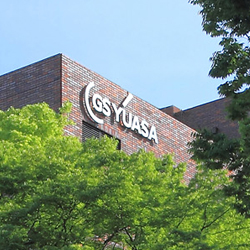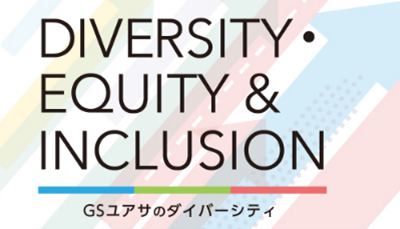Conservation and Improvement of Adequate Working Environment
We respect diversity and strive to create environments that enable all people to work without difficulty by making use of individual characteristics and to maintain and improve workplace environments where employees can perform their jobs with enthusiasm.
Human Capital Management
Responses to Human Capital and Diversity
The GS Yuasa Group believes that it is important to take advantage of the diverse values, experience, knowledge, and skills possessed by everyone working in our workplaces, pool our wisdom, and continue to create new value. The Group is working to reinforce its organizational capabilities and enhance human capital so that we can raise our corporate competitiveness over the medium to long term and continuously secure flexibility and resilience to withstand unexpected changes. In addition, we are working to provide a work environment that respects individual personalities and abilities and enables everyone to work with passion and a sense of fulfillment.
In order to undertake management that draws out the maximum value of human resources and leads to increased corporate value over the medium to long term, the Group’s core business company (GS Yuasa International Ltd.) formulates and implements plans in response to issues relating to human capital and diversity, and the Company’s Board of Directors supervises the Group as a whole including the provision of necessary guidance in response to the details of periodic progress reports from the core business company. The Sustainability Promotion Committee, a body established within the core business company to deliberate on, propose, and implement measures relating to sustainability issues overall, discusses policies, strategies, and key issues relating to human capital and diversity and reports to the Corporate Executive management meeting, which is under the authority of the president.
Number and ratio of newly hired employees (Fiscal 2024, GS Yuasa International Ltd.)
Please scroll sideways
| Age group |
Number of newly hired employees (person) |
Ratio (%) | Breakdown of newly hired employees (person) |
|||||
|---|---|---|---|---|---|---|---|---|
| New graduates |
Mid-career employees |
|||||||
| Male | Female | Male | Female | Male | Female | Male | Female | |
| 10’s | 26 | 2 | 11.5 | 0.9 | 26 | 2 | 0 | 0 |
| 20’s | 94 | 40 | 41.6 | 17.7 | 56 | 25 | 38 | 15 |
| 30’s | 42 | 10 | 18.6 | 4.4 | 0 | 0 | 42 | 10 |
| 40’s | 7 | 2 | 3.1 | 0.9 | 0 | 0 | 7 | 2 |
| 50’s | 2 | 0 | 0.9 | 0.0 | 0 | 0 | 2 | 0 |
| 60’s | 1 | 0 | 0.4 | 0.0 | 0 | 0 | 1 | 0 |
| Total | 172 | 54 | 76.1 | 23.9 | 82 | 27 | 90 | 27 |
Number of resignees and job turnover (Fiscal 2024, GS Yuasa International Ltd.)
| Age group | Number of resignees (person) | Job turnover (%) | |||
|---|---|---|---|---|---|
| Male | Female | Male | Female | Total | |
| 10’s | 0 | 0 | 0.0 | 0.0 | 0.0 |
| 20’s | 16 | 3 | 2.8 | 1.6 | 2.5 |
| 30’s | 31 | 7 | 3.6 | 4.3 | 3.7 |
| 40’s | 7 | 2 | 1.1 | 2.4 | 1.3 |
| 50’s | 8 | 0 | 0.7 | 0.0 | 0.7 |
| 60’s | 10 | 2 | 3.4 | 10.5 | 3.8 |
| Total | 72 | 14 | 2.1 | 2.3 | 2.1 |
Number and Breakdown of Employees (Fiscal 2024, GS Yuasa International Ltd.)
| Types of employees | Number (persons) |
Gender ratio by category (%) | ||
|---|---|---|---|---|
| Male | Female | Male | Female | |
| Regular employee | 3,130 | 578 | 84.4 | 15.6 |
| Fixed-term employee* | 300 | 20 | 93.7 | 6.3 |
| Total | 3,430 | 598 | 85.2 | 14.8 |
Contract employee, temporary employee, re-hired employee, etc.
Ratio of female employees to all employees
Please scroll sideways
| Scope of application | Eligible employees | FY 2020 | FY 2021 | FY 2022 | FY 2023 | FY 2024 |
|---|---|---|---|---|---|---|
| GS Yuasa International Ltd. | Regular employee | 13.6 | 14.1 | 14.7 | 14.7 | 15.6 |
| Entire Group | Regular employee and fixed-term employee | 11.2 | 11.1 | 10.6 | 9.7 | 9.9 |
Recommendations for Corrective Action Pursuant to the Labor Standards Act
Please scroll sideways
| Scope of application | FY 2020 | FY 2021 | FY 2022 | FY 2023 | FY 2024 |
|---|---|---|---|---|---|
| GS Yuasa International Ltd. | 0 | 0 | 0 | 0 | 0 |
| Entire Group | 0 | 0 | 1 | 0 | 0 |
TOPICS
Special Website on Diversity Established
In April 2020, GS Yuasa International Ltd. launched a special website to provide timely information on our approaches to diversity and the status of activities. The site presents easy-to-understand information regarding our measures for the targets, results, and initiatives associated with diversity and work style reforms, including the promotion of women's empowerment.
Going forward, we will actively disclose information on plans to provide opportunities for diverse human resources to demonstrate their full capabilities as well as the results of those plans.
Refer here for information on the special diversity website (in Japanese)TOPICS
Introduction of GLTD Program
The Group introduced a group long-term disability (GLTD) insurance program in November 2019 with the aim of creating an environment where employees can work with reassurance and expanding our benefits programs. If an employee requires an extended period of recuperation due to injury or illness, the GLTD program creates an environment that allows the employee to focus on recovery without worrying about income, supporting a rapid return to work. The program provides a certain level of income up to age 60 and adds supplementary benefits through the self-help efforts of employees.
TOPICS
Introduction of the Employee Stock Purchase Plan
As part of its employee benefits programs, the GS Yuasa Group has introduced the Employee Stock Purchase Plan for all employees, including fixed-term employees. Under this system, employees can enroll for as little as 1,000 yen, with contributions deducted from their wages. Furthermore, by subsidizing 10% of the contributions, the system allows employees to purchase Company stock and reduces their financial burdens, thereby supporting long-term asset building. Through this system, we deepen the attachment and sense of connection which employees feel toward the Company and aim to achieve sustainable growth by bringing the Company and its employees together.
Optimizing Work Hours
Ensuring Appropriate Working
Aiming to be a workplace that protects the health of employees and enables them to work with peace of mind, the GS Yuasa Group is striving to ensure the most appropriate work hours through cooperation between labor and management. GS Yuasa International Ltd. has introduced and managed systems to accurately understand and manage work hours (attendance management system and access control system). Moreover, an expert committee combining labor and management is held monthly, and we check the condition of employees working long hours and other related matters, making efforts to manage appropriate working hours.
We are taking steps to reduce labor hours for employees who had worked long hours by providing consultation with an industrial physician and through an advisory system (see "Work Style Reform" below) for supervisors. In addition, we provide compliance-related education with the themes of promoting understanding of work hour rules and appropriately managing work hours, to employees.
Our Group is committed to striving to prevent overwork by consolidating an environment which allows all employees to work within appropriate working hours. We also actively promote initiatives to prevent overwork both within the Group and throughout our entire supply chain.
Changes in average annual total working hours (GS Yuasa International Ltd.)
Please scroll sideways
| Items | FY 2020 | FY 2021 | FY 2022 | FY 2023 | FY 2024 | Remarks |
|---|---|---|---|---|---|---|
| Average annual fixed working hours | 1,710 | 1,697 | 1,687 | 1,690 | 1,697 | The hours refer to those calculated by deducting holiday hours and hours of absence (late arrivals, early departures, etc.) from fixed working hours. |
| Average annual overtime working hours | 196 | 198 | 205 | 192 | 179 | Monthly average number of overtime hours worked: 14.9 hours (FY 2024) |
| Total | 1,906 | 1,895 | 1,892 | 1,882 | 1,876 |
Notes: Employees do not include personnel on leave or those working overseas.
Period: January to December
Work Style Reform
At GS Yuasa Group, labor and management are working as one to reduce long work hours and encourage employees to take annual paid leave with the aims of improving work efficiency and enhancing creativity at work by making sure employees stay physically and mentally healthy.
Examples of initiatives to provide variation in work style (GS Yuasa International Ltd.)
- Setting one "no overtime" day a week
- Making it compulsory to take at least 10 days of annual paid leave
- Setting Work-life synergy leave (consecutive paid leave is recommended)
- Prohibiting two consecutive days of work on prescribed holidays
- In principle, prohibiting late-night overtime work (10 p.m. to 5 a.m.)
- Postponing the start-time next day in case of overtime work till late night (securing rest time)
- Introducing a system to monitor employees working in excess of the standard hours, and providing advice to supervisors on how to deal with overtime issues
- Promoting improvement activities that contribute to the enhancement of work efficiency and creativity and the optimization of work allocation
- Implementing a commendation system for improvement activities that have enhanced workability and productivity beyond a certain level
Status of Annual Paid Leave Taken (GS Yuasa International Ltd.)
Please scroll sideways
| Items | Unit | FY 2019 | FY 2020 | FY 2021 | FY 2022 | FY 2023 | Eligible employees | Method of Calculation |
|---|---|---|---|---|---|---|---|---|
| Ratio of taking annual paid leave | % | 77.8 | 79.2 | 83.3 | 84.3 | 85.8 | General employees | Total number of days of paid leave taken divided by Total number of days of annual paid leave |
| Ratio of acquisition for the number of statutory days granted | % | 93.3 | 94.2 | 98.2 | 100.9 | 99.2 | General employees | Total number of days of paid leave taken divided by Total number of days of statutory paid leave granted |
| Average number of days of annual paid leave take | Days | 16.5 | 16.8 | 17.8 | 18.0 | 18.4 | General employees | Total number of days of paid leave taken divided by Total number of subject persons |
Notes: Employees do not include personnel on leave or those working overseas.
Period: September to August
Payment of Proper Wages
Securing the Minimum Wage
In order for employees to live a safe and healthy life, it is important that wages that are the source of daily bread for employees are paid properly and reliably.
In order to ensure employee wages are calculated accurately and payments made without delay, the Group operates thoroughly based on internal rules that establish methods for paying appropriate labor compensation and so on. In addition, the Group also provides clearly comprehensible payment statements when making wage payment, and enough information is included on the payment statement to verify labor compensation. Further, there is no system (gender-based wage structure, personnel evaluation standards etc.) that lead to gender pay gaps.
Besides paying employees a basic salary above the local minimum wage, the Group promotes initiatives to ensure fair treatment regardless of type of employment.
Comparison of standard newcomer salary to local minimum wage (Fiscal 2025, GS Yuasa International Ltd.)
| Occupation | Ratio (average) |
|---|---|
| Career-track positions | 150% |
| Manufacturing jobs, clerical work | 127% |
Calculated based on data on status of minimum wage revisions by region (Ministry of Health, Labour, and Welfare)
Mid to Long-term Human Resources Development
Fostering Autonomous-minded Human Resources
The GS Yuasa Group focuses efforts on the development of autonomous-minded human resources and support measures through on-the-job training* centered on the management by objective system so that we can achieve “innovation and growth,” our corporate philosophy. Autonomous-minded human resources refer to personnel who have high motivation for personal growth and the ability to manage themselves and are able to act on their own initiative. The Group actively invests in the development of the autonomous-minded human resources who will play key roles in the future. The Group has also established educational programs that provide self-initiatives learning opportunities so that all employees can promote self-innovation. Furthermore, we are investigating personal programs that enable employees to perform important roles and participate in business regardless of age or experience and receive evaluations commensurate with their results. The Group believes that through these measures, we can increase the mobility of human resources within the Company, promote individual growth and engagement, and accelerate the creation of new value. Developing leaders with global perspectives is essential for the Group‘s sustainable growth. Accordingly, we not only encourage human resource mobility among businesses, we also systematically conduct training and talent management to develop the next generation of leaders.
A method of human resource development where knowledge and skills are gained through practice at the worksite.
Fundamentals in human resource development
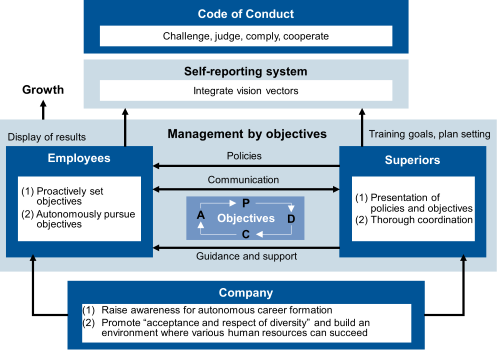
Training system by rank
Please scroll sideways
| Rank | Training name |
|---|---|
| Tentatively hired applicant | ●Tentative hire training |
| First year after hiring | ●New employee training (excluding mid-career employees) ●New-employee follow-up training (excluding mid-career employees) ●Mid-career employee training (only mid-career employees) ●CSR, compliance, environmental issues, and health and safety training |
| Second year after hiring | ●Logical communication training |
| Third year after hiring | ●Skills improvement training ●New employee supporter on-the-job training ●CSR and health and safety training |
| Fourth year after hiring | ●Power-up training ●New employee supporter on-the-job training ●CSR and health and safety training |
| Sixth year after hiring | ●Career advancement training ●Career enhancement follow-up training ●New employee supporter on-the-job training ●CSR and IR training |
| Assistant manager | ●New leader training ●Next-generation business leader development training ●Career interview support training ●CSR, environmental issues, and health and safety training |
| Manager | ●New manager training ●Management training (management follow-up training) ●Next-generation business leader development training ●CSR and compliance training |
| General manager | ●New division manager training ●Next-generation business leader development training ●CSR, compliance, and environmental issues training |
Training system by category
Please scroll sideways
| Classification | Training name |
|---|---|
| Rank | (See training system by rank) |
| Business Skills | ●Logical communication training ●Facilitation training ●Time management training ●Project Management Training ●Training for coaching ●English email writing training ●Technical and skills classroom courses |
| Acquiring Certifications | ●Machine Maintenance Skills Test ●The Japan Business Law Examination (external) ●Business Accounting Examination (external), ●Quality Control Test |
| Personal Development | ●TOEIC ●Online language lessons ●Distance learning, online courses |
| Diversity | ●Training for women leaders’ career advancement ●Training for diversity management (managerial positions) ●Leadership enhancement program ●Women’s health management program ●Diversity management program |
| Global Human Resource Development | ●Overseas practical training program (Training of candidates for overseas assignments) ●Pre-overseas assignment training (language, management skills, etc.) ●Training for nurturing next-generation management |
| Career autonomy | ●Rank-based career design training ●Career design training 42 (for employees in their 40’s) ●Career design training 57 (for employees in their 50’s) ●Career interview support training (management positions) |
Training hours for human resources development (Fiscal 2024, GS Yuasa International Ltd.)
| Item | Classification | Average training hours (Hour/Person) |
Total training hours (Hour) |
|---|---|---|---|
| Gender | Male | 6.66 | 22,849 |
| Female | 9.30 | 5,560 | |
| Total | 7.05 | 28,409 | |
| Employee category | Regular employees | 7.62 | 28,238 |
| Fixed-term employees | 0.53 | 171 | |
| Total | 7.05 | 28,409 |
Employee Career Development Support
The GS Yuasa Group implements measures to help employees achieve their individual career visions while creating new value for the company.
To bolster our efforts for diverse career development by employees, we introduced age-based career design training that promote career autonomy to supplement existing rank-based career development training. We also conduct support training to enable managers to conduct effective career interviews, thereby supporting the career autonomy of employees.
In addition, we launched a program that promotes the development of human resources with the skills needed to carry out digital transformation with the objective of having employees acquire skills in line with our management strategies. Going forward, we plan to introduce training that allows employees to select the courses they will take with the aims of having employees acquire the skills and techniques necessary for their individual work and improving creativity in new businesses. Furthermore, we launched a new business idea proposal program as a mechanism that enables employees to utilize their individual skills and advance their careers. This program is intended to create new business opportunities by providing all employees opportunities to propose new business ideas.
We are also taking measures to promote the operation of a career goal self-reporting system and encourage rank-based career development training to support the autonomous career development of employees. In addition, we introduced an in-house recruiting system for recruiting human resources from within the company, thereby responding flexibly to business strategies and implementing measures that enable employees to autonomously develop their own careers.
Respect for Individual Work-Life Balance
Promoting Women's Empowerment
At GS Yuasa International Ltd., we are committed to increasing opportunities for female employees to play an active role by supporting the two axes of "career development" and "support for work-life balance."
In 2018, the Company launched the GY Mirai Project to actively recruit diverse human resources and continuously develop an environment that allows each individual to make the most of their individuality and abilities, and to create a workplace where each individual can continue to work with enthusiasm and fulfillment. Further, top management regularly sends out messages to all employees about the importance and significance of promoting women's empowerment.
President's Message
We are committed to "fostering autonomous-minded human resources" and "diversity and inclusion," and to the actualization of our corporate philosophy of "Innovation and Growth."
Our objective is to be a company where individuals and organizations can both grow by respecting the individuality and capabilities of each person with diversity as a source of competitiveness for building a sustainable future.
We adopted "the three Ls" as our slogan and cultivate diversity, equity, and inclusion that enables all employees to continue shining, embracing their individual capabilities.
The "three Ls"
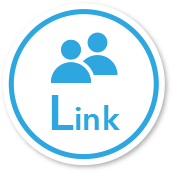
Strengthen links among our people

Support for work and life events

Lead women toward opportunities
for autonomy and growth
DE&I at GS Yuasa International Ltd.
| Diversity | Respect the individuality and abilities of each individual and accept diverse perspectives |
| Equity | Provide equal opportunity to play active roles through individualized support |
| Inclusion | Develop a workplace culture where all opinions are accepted and individuals and organizations can grow together |
Roadmap for promoting women’s empowerment
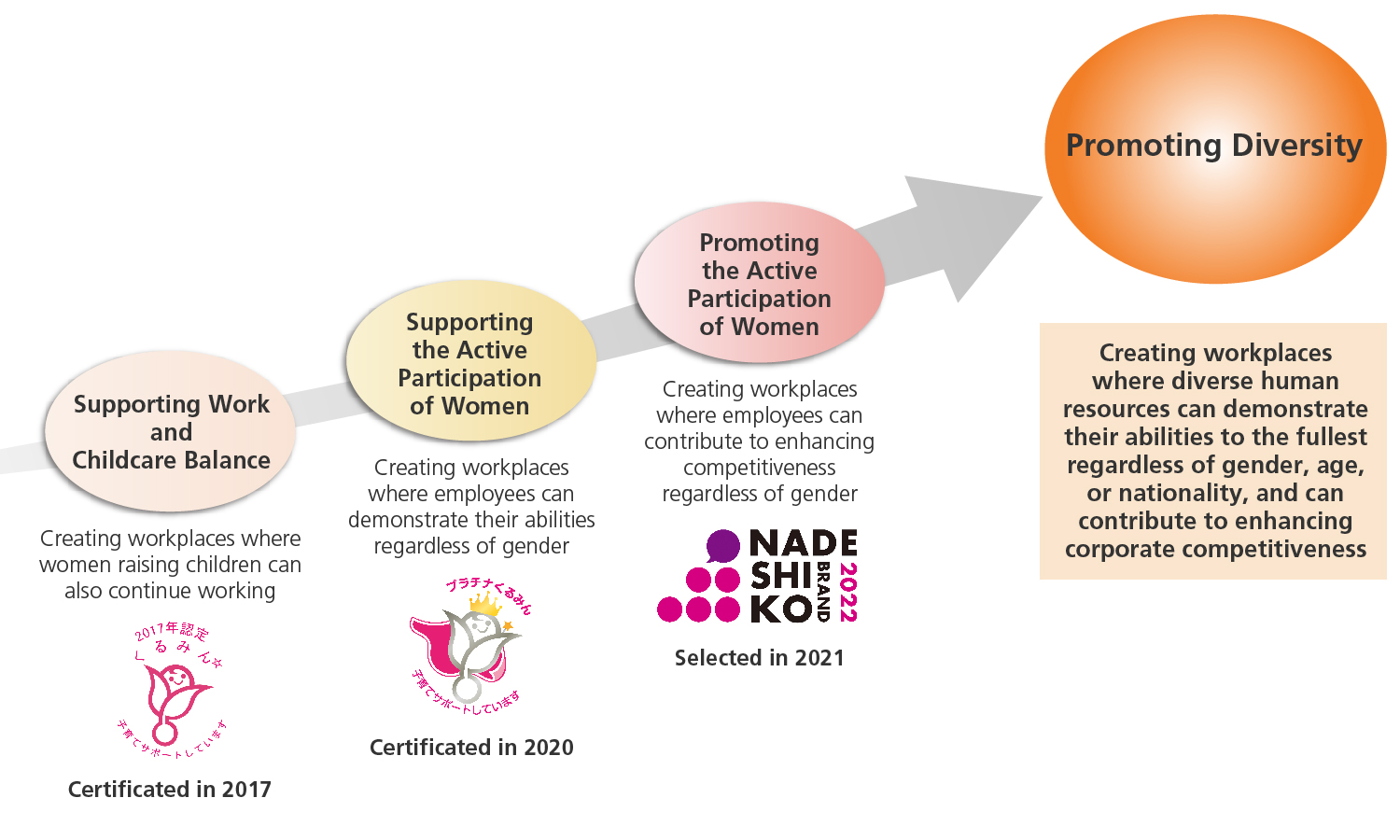
Action Plan Promoting Women's Empowerment (April 1, 2023 to March 31, 2026)
- Objective 1Raise ratio of women in managerial positions to 6% or more by the end of March 2025
- Objective 2Raise ratio of women among new graduates recruited for career-track positions every year to over 30%
- Objective 3Increase the percentage of paid leave taken by all general employees to 70% or more each fiscal year
Important management indicators regarding measures to promote the active participation of women (unit: %)
| Classification | Targets (FY2025) |
Results (FY2024) |
|---|---|---|
| Ratio of women in new graduates hired for career-track positions | 30 or more | 27.0 |
| Ratio of women in the workforce | 17 or more | 15.6 |
| Ratio of women in managerial positions | 6 or more | 4.6 |
| Ratio of women at assistant managers rank | 12 or more | 9.1 |
| Ratio of male employees’ taking childcare leave | 100 | 71.3 |
Initiatives to expand opportunities for active participation of female employees
- Establishing processes for incorporating initiatives to promote women’s empowerment in evaluation indicators for managers and evaluation criteria for appointment to managerial positions
- Ensuring fairness in promotions and appointments (responding to life events) and assigning roles according to expertise
- Strategic appointment of female managers and officers (including medium- to long-term securing of female employees with advanced abilities and high motivation for promotion)
- Considering mid-career recruitment of female managers (including candidates for managerial positions)
TOPICS
Selected for the fiscal 2021 Nadeshiko Brand
In March 2022, our company was selected for the Nadeshiko Brand that is jointly sponsored by the Ministry of Economy, Trade and Industry and the Tokyo Stock Exchange. The Nadeshiko Brand aims to promote investment in companies and accelerate corporate initiatives by introducing listed Japanese companies that excel in promoting women's empowerment every fiscal year to investors who place importance on improving corporate value over the medium to long term.
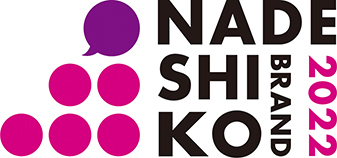
TOPICS
Conducting Career Advancement Training for Female Employees
The Group conducts training for female employees with it the aim of increasing the percentage of managerial positions filled by women. In fiscal 2024, we conducted career advancement training for female assistant manager candidates in order to develop assistant managers who can become management candidates. The training program included panel discussions featuring female managers from within the Company and guest lecturers with the objective of fostering a mindset of envisioning one’s career while facing the challenges and concerns of career development for positive career advancement. By making participants feel that leadership positions are more accessible, we are promoting a mindset shift that considers assistant manager and manager positions as future career options.
Employment of People with Disabilities
To promote the employment of people with disabilities, GS Yuasa International Ltd. offers a wide range of opportunities to people with disabilities, including in a company certified as a special subsidiary* in December 2007.
As of April 1, 2025, GS Yuasa’s employment rate of people with disabilities meets the legally mandated employment rate of 2.5%.
We will continue to manage employment so that people with disabilities can put their skills and qualities to good use in an effort to maintain and improve a pleasant work environment.
Special subsidiary: A system based on the Disabled Persons Employment Promotion Law, under which, when a subsidiary is certified by Japan's Ministry of Health, Labor and Welfare as giving special consideration to the employment of people with disabilities, it can be regarded as one of the parent company's business establishments when calculating the employment rate of people with disabilities.
Change in employment rate for persons with disabilities
| Scope of application | April, 2021 | April, 2022 | April, 2023 | April, 2024 | April, 2025 |
|---|---|---|---|---|---|
| GS Yuasa International Ltd. | 2.56 | 2.68 | 2.52 | 2.64 | 2.93 |
Rehiring of Elderly Employees
At GS Yuasa International Ltd., we operate a rehiring system by which employees who have reached mandatory retirement age can continue to work and utilize their wealth of experience and high-level skills and abilities. If an employee who has reached mandatory retirement age wishes to extend his or her employment with us, appropriate decisions on conditions and personnel assignment are made based on an evaluation of job necessity, the employee’s work ability, and other factors. Furthermore, as with currently active employees, we operate a work target management system and reflect job performance in conditions so that rehired employees can work with motivation.
In the future, as Japanese society continues to be characterized by a low birthrate and further aging, the securing of human resources is expected to become increasingly difficult. Not only does our Group see the employment of senior citizens as one measure to alleviate the labor shortage, but we aim to improve our capacity for sustained business growth by enabling outstanding elderly people to display their skills and know-how.
State of Rehiring of Elderly Employees (Fiscal 2024, GS Yuasa International Ltd.)
| Classification | Number of rehired employees (persons) |
Rehiring ratio (%) |
Employment ratio of rehire applicants (%) |
|---|---|---|---|
| Male | 58 | 73.4 | 100 |
| Female | 3 | 100 | 100 |
| Total | 61 | 74.4 | 100 |
Rehiring ratio: Ratio of rehired employees to retirees.
Employment ratio of rehire applicants: Ratio of employment of retirees wishing to be rehired.
TOPICS
Life-Planning Seminars Held
GS Yuasa International Ltd. conducts seminars on career training and life-planning targeting employees above 50 and 57 years of age. The aim of life-planning seminars is to support employees in deepening their understanding of life-money planning and asset management and assist them in leading an enriched second life after retirement.
Supporting Work Alongside Childcare/Nursing Care
At GS Yuasa International Ltd., we aim to create an environment that makes it easy for employees to participate in childcare and nursing care and to this end we have established a support system for childbirth, childcare, and nursing care. To encourage employees to use this system, we have also set up an in-house electronic message board called Childcare & Nursing Care Support, where we provide information on childcare- and nursing-related systems to employees. Further, the company has released a Handbook on Supporting Work-Childcare Balance targeting superiors and subordinates, and distributed it to all employees. In addition, we aim to create workplaces where all employees, regardless of gender, can use the systems, by raising awareness of the systems through trainings by rank for the management as well, and by other means.
Starting in fiscal 2025, we introduced a Selective Employee Benefits System (Cafeteria Plan) that allows employees to choose benefit programs according to their individual lifestyles and needs. The system provides various support programs for childcare and nursing care as well as leisure support, such as self-development and recreational activities. For employees performing childcare and nursing care, we subsidize costs related to the purchase or rental of equipment and use of facilities and services.
In the future, we will continue our efforts to develop workplace environments and further enhance systems that enable employees to maximize their abilities while balancing work with childcare and nursing care responsibilities.
Childbirth, Childcare and Nursing care support systems
Please scroll sideways
| Item | System | Details |
|---|---|---|
| Childbirth, Childcare |
Alleviation of commutation during pregnancy |
System under which work at the beginning or the end of working hours is exempted for female employees who are pregnant (up to 60 minutes/day) |
| Maternity leave | System under which a leave of absence for six weeks before childbirth (14 weeks in case of multiple pregnancy) and eight weeks after childbirth can be obtained |
|
| Leave for going to hospital during pregnancy/ maternity protection leave |
System under which female employees who are pregnant or have spent only less than one year after childbirth can obtain a leave for medical examination, etc. |
|
| Maternity protection leaves | System under which female employees who are pregnant or have spent only less than one year after childbirth can take leave (up to one year) |
|
| Paid leave for births | System under which employees who have a newborn can take leave (three days) |
|
| Childcare leave | System under which employees who are bringing up a child/children can take leave (as the maximum period, until a child reaches the age of two) |
|
| Short-time working due to childcare |
System under which employees who have a child in the sixth grade or under in elementary school or a child with disability can work for a short time or work with a flexible schedule |
|
| Nursing care or other leave | System under which employees can take leave for nursing a child in the sixth grade or under in elementary school (five days/year for one child; ten days/year for two children or more) |
|
| Childcare time | System under which employee with a child under the age of one year can take time off |
|
| Exemption/limitation of overtime work and late-night work |
System under which employees who are raising a child can be exempt from/limit overtime and late-night work |
|
| Issuing discount vouchers for babysitter dispatch services | A system in which employees who use babysitters can avail subsidized usage fees (up to 4,400 yen/day per child) |
|
| Subsidies for use of childcare facilities and services | A system that subsidizes expenses for daycare facilities, babysitters, and other use fees for employees with a child who has not entered elementary school |
|
| Subsidies for purchase or rental of childcare goods | A system that subsidizes expenses for purchase or use of childcare goods for employees with a child who has not entered elementary school |
|
| Nursing care |
Long-term nursing care leave | System under which employees who are caring for a family member can take leave (up to one year) |
| Short-term nursing care leave | System under which employees can take leave for nursing a family member (five days/year for one person; ten days/year for two persons or more) |
|
| Short-time working due to nursing care |
System under which employees who are caring for a family member can work for a short time or work with a flexible schedule (up to three years) |
|
| Exemption/limitation of overtime work and late-night work |
System under which employees who are caring for a family member can be exempt from/limit overtime and late-night work |
|
| Subsidies for use of nursing care facilities and services |
A system that subsidizes expenses for nursing care and nursing care services for employees caring for a family member within the second degree of kinship, including a spouse |
|
| Subsidies for purchase or rental of nursing care goods |
A system that subsidizes expenses for the purchase or rental of nursing care goods for employees caring for a family member within the second degree of kinship, including a spouse |
|
| Others | Accumulated leave | System under which employees can accumulate the number of days for annual paid leave whose validity has expired (up to 40 days, acquired for the reason of nursing care for a family member or raising a child in the third grade or under in elementary school, etc.) |
| Leave in hourly units | System under which employees can take leave in hourly units from granted annual paid leave (maximum of 40 hours/year) |
|
| Telecommuting program | A program that allows employees to work from home, so they can balance work with childcare or nursing care |
|
| Return to work program | A program for rehiring employees who left work for childcare, nursing care or other similar reasons to return to work if certain conditions are met |
Utilization of Childcare Support System (Childcare Leave) (GS Yuasa International Ltd.)
Please scroll sideways
| Fiscal year | Females | Males | ||||
|---|---|---|---|---|---|---|
| Number of users (person) |
Usage rate (%) |
Return-to-work rate (%) |
Number of users (person) |
Usage rate (%) |
Return-to-work rate (%) |
|
| 2020 | 14 | 100 | 100 | 9 | 9.1 | 100 |
| 2021 | 21 | 100 | 100 | 27 | 22.5 | 100 |
| 2022 | 15 | 93.8 | 100 | 49 | 45.4 | 100 |
| 2023 | 21 | 100 | 100 | 84 | 63.6 | 100 |
| 2024 | 23 | 100 | 100 | 87 | 71.3 | 100 |
Utilization of Nursing care support system (GS Yuasa International Ltd.)
| FY | Long-term nursing care leave |
Short-term nursing care leave |
||
|---|---|---|---|---|
| Number of users (person) |
Return-to-work rate (%) |
Number of users (person) |
Total Number of days (day) |
|
| 2020 | 1 | 0 | 24 | 116.0 |
| 2021 | 1 | 0 | 23 | 70.1 |
| 2022 | 3 | 33.3 | 40 | 161.5 |
| 2023 | 4 | 100 | 43 | 129.0 |
| 2024 | 1 | 0 | 74 | 292.0 |
Note concerning nursing care leave use data: From fiscal 2020 to fiscal 2022, the calculation period for short-term nursing care leave was for September to August of the following year, but starting in fiscal 2024, the calculation period was changed to April to March of the following year. Accordingly, data was compiled for fiscal 2023 as a transition period covering the seven-month period from September 2023 to March 2024.
TOPICS
GS Yuasa has received Platinum Kurumin* certification
GS Yuasa has long worked to create environments where employees can continue to work while caring for children and first received Kurumin certification in 2017. Since then, we have established action plans to promote support and enhance its effects, expanded the applicable period of the program for reduced working hours for childcare, introduced a telecommuting program for employees who are taking care of children, and took other measures, leading to the Platinum Kurumin certification in fiscal 2020.
The Group is committed to promoting the creation of workplaces where employees can balance work and childcare with peace of mind.
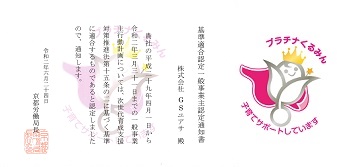
Platinum Kurumin is a program of certification granted by Japan’s Ministry of Health, Labour and Welfare to organizations that provide high levels of childcare support.
TOPICS
Conducting Information Exchange Meetings on Work-Childcare Balance
GS Yuasa International Ltd. has been conducting information exchange meetings twice a year since fiscal 2019, with the objective of supporting employees, to balance work and childcare successfully and engage in work with a sense of fulfillment. Presentations on experiences of employees who use the company's childcare support system while being actively engaged in work, and exchange of views among participants, are meaningful occasions for both employees who are balancing work and childcare and those who are in the midst of challenging themselves to achieve this balance going forward. In addition, majority of the participants in these information sessions are male employees, demonstrating that the percentage of male employees availing childcare leave in the Group is rising year by year.
Business Operations Considering Religious Customs
At the GS Yuasa Group's overseas sites in Indonesia where Muslims are the large majority, we are conducting business operations considering Islamic traditions and customs. PT. Yuasa Battery Indonesia, PT. Trimitra Baterai Prakasa and PT. GS Battery have a mosque in their respective offices. These companies allow employees to offer prayers at a mosque during working hours, and Muslims gather for prayers on Fridays from both the office and outside the company. We also established a multi-purpose room that can be used as a mosque on the site of the Group’s Kyoto Plant and allow employees to pray during working hours.
The GS Yuasa Group believes that understanding and respecting customs, cultural values and religion in each region are indispensable for building a good relationship with local employees and effectively operating businesses.
Supporting Volunteer Activities by Employees
At GS Yuasa International Ltd., we introduced a volunteer leave program to establish an environment where employees can participate in social contribution activities under their own initiative. This program enables employees to participate in volunteer activities (such as environmental preservation, social service, and social welfare) under their own initiative so that they can have a positive impact on their local communities. By providing an environment where employees can engage in social contribution, we seek to encourage self-actualization and heightened awareness of social issues by employees.
As work styles and ideas concerning time off diversify, the Group is working to increase employee engagement by responding flexibly to changing employee lifestyles and preferences.
Occupational Health and Safety Management
Promoting Occupational Health and Safety
The GS Yuasa Group believes that securing the health and safety of its workers is the paramount priority in doing business and has established the Group Policy (The Fundamental Health and Safety Policy) for the promotion of company-wide endeavors to build a corporate culture of safety. Furthermore, to ensure the health and safety of all employees who work for the Group directly or indirectly including subcontractors and temp workers, we have appointed an organization to conduct group-wide integrated management of health and safety. This has been instrumental in strengthening health and safety management at both domestic and overseas business sites and Group companies. In addition, we are undertaking initiatives based on our Fundamental Health and Safety Policy by creating organizational structures centered on safety and health committees established in business divisions and companies.
Our Group’s domestic business sites have obtained the occupational health and safety management systems in compliance with international standards (ISO 45001) certification. In addition, a majority of the production companies of our overseas Group companies have also obtained ISO 45001 certification. Our Group companies in Japan are currently working to acquire ISO 45001 certification and seek to achieve effective management aimed at Group-wide attainment of the Fundamental Health and Safety Policy. We are committed to continual improvement of our health and safety performance by making effective use of systematic mechanisms based on the PDCA cycle.
Fundamental Health and Safety Policy
-
Fundamental Philosophy
We will create a corporate culture that ensures worker's safety and health.
-
Action Agenda
Top management presents the following action agendas for the succession of advanced energy technologies developed in our battery business and for the realization of our fundamental philosophy.
- We will fulfill legal requirements, invest resources and stipulate procedures for all of our operations in order to ensure a healthy and safe working environment.
- We will promote continuous improvement to the management system to achieve determined goals for health and safety.
- Managers/supervisors will grasp the root causes of dangers associated with safety and health and take measures systematically to lower their risks.
- Through conference and discussion, managers/supervisors will reflect opinions of employees to activities promoting health and safety.
- Managers/supervisors will not overlook unsafe behavior of employees and will provide guidance to correct them.
- Employees will follow predetermined rules related to safety and health in order to protect their own selves.
- Employees will make a report to their superiors requesting for improvement of facilities or procedures when he or she finds the root cause of danger.
- ISO 45001 certification acquisition rate at domestic and overseas production sites
- 94%
Overview of Organizational Structure
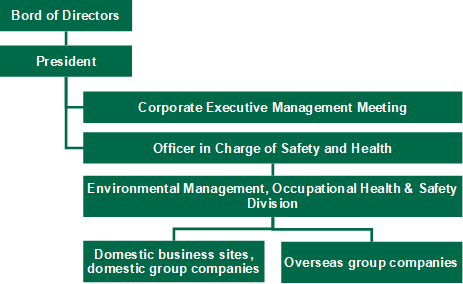
Reducing Occupational Accident Risk
At domestic business sites and domestic group companies, we identify potential hazard sources by conducting general inspections using risk assessment methods and take mitigation measures according to the scale of the risk. Similar measures are also taken concerning safety patrol activities conducted under the leadership of the safety and health officer. In the event of an industrial accident, information on accident occurrence status is shared with all employees at domestic business sites in a timely manner, the cause of the occurrence is investigated, and measures are taken to prevent recurrence. In workplaces dealing with hazardous substances, we take risk reduction measures utilizing risk assessment of chemical substances, and regularly monitor the working environment and workers’ health in accordance with laws and regulations.
Since fiscal 2020, we have been focusing on adopting essential measures (including eliminating hazard sources) and engineering measures (including improvements towards equipment that comes with safety functions) to eradicate “getting stuck or caught in machinery” accidents which are the top industrial disasters. We also implement ergonomic measures (such as encouraging the use of power assist suits that reduce the physical burdens on workers) by workers who perform work that imposes physical burdens. In addition, to prevent the occurrence of lower back pain associated with the carrying of heavy objects, working for extended periods, and repetitive work, we are working on strict implementation of operations based on safety guidelines and on the creation and distribution of videos on prevention of back pain.
Also, the Group’s personnel responsible for promoting health and safety conduct regular safety audits of overseas sites and take other action as a part of our efforts to mitigate the risk of occupational accidents at overseas Group companies.
Implementation period of safety and health risk assessment
- Adoption of new raw materials or changes in raw materials
- Adoption of new equipment or changes in equipment
- Adoption of new work methods and procedures or changes in work methods and procedures
- Installation, repair, and dismantling of structures
- Occurrence of occupational accidents
- Changes in risk factors (aging of machinery, equipment, etc.)
Status of occurrence of occupational accidents (GS Yuasa International Ltd.)
| FY 2020 | FY 2021 | FY 2022 | FY 2023 | FY 2024 | |
|---|---|---|---|---|---|
| Missed work frequency rate*1 | 0.55 | 0.30 | 0.60 | 0.36 | 0.58 |
| Average frequency rate in manufacturing industry | 1.21 | 1.31 | 1.25 | 1.29 | 1.30 |
| Rate of intensity*2 | 0.00 | 0.00 | 0.01 | 0.01 | 0.02 |
| Average rate of intensity in manufacturing industry | 0.07 | 0.06 | 0.08 | 0.08 | 0.06 |
1 Missed work frequency rate is the number of people missing work per 1,000,000 work hours
2 Rate of intensity is the number of lost days due to accidents per 1,000 work hours
Targets related to occupational accidents risk (Fiscal 2025)
Please scroll sideways
| Items | Target | |
|---|---|---|
| Domestic business sites | Overseas Group companies | |
| Number of serious occupational accidents | None | None |
| Number of workers not meeting our blood lead concentration management standards | None | None |
| Number of accidents resulting in missed work | 2 or less | 26 or less |
Raising Worker Awareness Concerning Safety
The GS Yuasa Group conduct activities intended to raise the awareness of safety among all employees who work for the Group directly or indirectly including subcontractors and temp workers in order to maintain and improve safety and health management operations. We also ensure that safety and health activities are well-established and raise their levels by conducting education and training to prevent safety and health risks from occurring.
From fiscal 2023, we have also introduced virtual reality (VR) experience-based training devices as part of our educational initiatives on hazard simulation which allow trainees to actually experience and understand workplace hazards. We are committed to continued efforts to promote health and safety education through hands-on training for hazards (such as falls from working at heights, contact with forklifts, and electric shocks), that could not be experienced in the past with conventional devices.
Examples of activities for raising safety awareness
- Posting statements of management intent concerning occupational safety at all worksites
- Distribution of safety compliance cards with basic site safety information
- Periodically conducting safety and health awareness surveys
- Display of awareness posters for raising awareness of basic safety behavior* in the premises
Such as not walking with your hands in your pockets, not using cell phones while walking, holding a railing when climbing or going down stairs, not crossing diagonally, ensuring pointing and calling when crossing
Examples of education and training to prevent safety and health risks from occurring
- Periodic training on hazard avoidance techniques (including risk prediction and risk assessment)
- Periodic experience-based risk training (including suppliers)
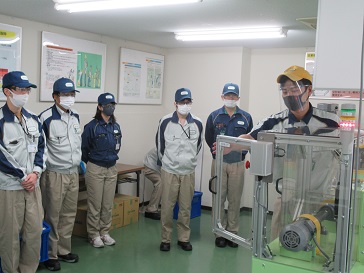
Experience-based risk training (Kyoto Plant)
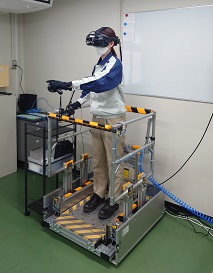
VR experience-based risk training (Kyoto Plant)
Participation in safety and health education (Fiscal 2024, GS Yuasa International Ltd.)
Please scroll sideways
| Classification | Items | Number of participants (persons) | Intended audience |
|---|---|---|---|
| General education | Experience-based risk training | 2,459 | All employees (including contractors), suppliers |
| Courses on risk assessment | 89 | ||
| Training for hazard prediction | 36 | ||
| Specialized education | Education of safety trainers | 190 | Persons (including contractors) promoting activities for workplace safety |
Health Management
Health Management Initiatives
The GS Yuasa Group believes that in order to realize our corporate philosophy of "Innovation and Growth," it is important that we create workplace environments to enable our all employees to perform their duties while maintaining good physical and mental health so as to demonstrate maximum performance. To this end, we are promoting company-wide initiatives to maintain and improve the health of employees and their families, in accordance with the Health Management Policy, formulated by the company president, and the Health Code of Conduct, which outlines specific behavioral guidelines for employees.
In addition, we position employee health as an important management issue and seek to improve productivity and enhance the medium- to long-term corporate value of the entire group by fostering a corporate culture that emphasizes health and establishing workplace environments that facilitate work. To achieve this, we formulated a Health Management Strategy Map as a strategy for making effective investment in health. This strategy map sets health management indicators in stages and proceeds by visualizing and verifying the effectiveness of initiatives, thereby maximizing the quality and outcomes of health measures.
The Group will continuously and systematically promote health management initiatives by utilizing various evaluation criteria to encourage changes in employee health status and health awareness and behavior in order to achieve the final targets of our health management strategy.
Health Management Policy
In order to realize the “Innovation and Growth” of our employees and business entities, the GS Yuasa Group supports employees and their families in collaboration with health insurance society so as to ensure that they maintain their own health and encourages "health promotion" so that all employees can work zealously and with a sense of fulfillment.
- We strive to prevent the onset and severity of lifestyle-related diseases and mental disorders.
- We support managing of both work and medical treatment so that everyone can engage in decent work.
- We encourage health promotion to maintain and improve health.
Health Code of Conduct
Strive to realize our corporate philosophy of "Innovation and Growth" by having each employee address their health in the following ways and creating workplaces that are healthy and vibrant, both physically and mentally.
Proactive maintenance and management of health
- Ability to understand one’s mental and physical condition and recognize health issues
- Ability to autonomously review lifestyle habits to maintain better health
- Ability to bot mindful of work-life balance and make efforts to maintain an appropriate amount of rest and vitality
Contribution to the creation of a work-friendly corporate culture (health culture)
- Participation in creating a workplace where people care about each other’s health and support each other
- Ability to utilize consultation services and support programs for balancing work and personal life as needed
- Active participation in health management initiatives and commitment to fostering health culture
Final Targets under the Health Management Strategy
Please scroll sideways
| KPI | Target Value | Result | Explanation of KPI | |
|---|---|---|---|---|
| FY 2025 | FY 2023 | FY 2024 | ||
| Presenteeism | 67 points or more | 64.9 points | 66.2 points | An indicator for assessing the state where an employee’s work performance ability and productivity have declined due to poor physical condition or other factors. |
| Absenteeism | 3.5 days or less | 3.9 days | 3.9 days | An indicator measuring labor losses due to employee absence and leave due to illness |
| Work engagement | 50 or more | 50.3 | 51.0 | An indicator for visualizing the psychological state of employees who are motivated and fulfilled in their work |
Actual values for presenteeism and work engagement in fiscal 2024 were measured using a sample of 3,837 employees, with a response rate of 90.2%.
For absenteeism, the number of days reported by employees when absence or leave due to illness extends to seven or more days is totaled.
Work engagement figures are calculated as deviation values.
Please see here for our Health Management Strategy Map (in Japanese)Promotion Framework
The Company positions the president as the chief officer of health management and works to promote health management across the entire Group. Important issues related to health management are discussed by the Sustainability Promotion Committee, a body established within the core business company, and content will be reported to the Sustainability Committee, which is made up of the management team of the core business company. In addition, the Group collaborates with the health insurance society to conduct health management promotion meetings attended by the health management officer (who concurrently serves as chairperson of the health insurance society) and labor union executives to promote measures to address employee health issues. Regarding the occupational health system, we assigned a dedicated general occupational health physician to the head office, appointed occupational health physicians at major offices, and have 10 full-time nurses and public health nurses. Further, in order to detect mental disorders at an early stage and prevent them from becoming severe, we have established an environment that is conducive to counseling by clinical psychotherapists that can be accessed regularly at our head office and major business sites.
Promoting Autonomous Health Management
At GS Yuasa International Ltd., the Group’s core business company, to encourage individual employees to autonomously address their own health and promote lifestyle improvements, we set behavioral targets for six areas: exercise, diet, rest and sleep, alcohol consumption, smoking, and health checkups and medical visits. By encouraging good practices in each of these areas, we seek to maintain and improve employee physical and mental health and link this to improved work performance and productivity. Going forward, we will continuously monitor the percentage of employees who achieve the targets for four or more of the six items as an indicator to evaluate employees’ ability to autonomously choose healthy behaviors (health literacy), and based on the results, we will promote self-care.
By implementing various measures relating to the behavior targets, the Group will support improved health literacy and the realization of employee well-being.
Details of Behavioral Targets Relating to Lifestyle Habits
| Item | Behavioral target | Behavioral indicator |
|---|---|---|
| Exercise | Make exercise a habit and develop a healthy body | Exercise for at least 30 minutes per session at least two days per week |
| Diet | Maintain a healthy body weight and prevent lifestyle-related diseases | Maintain a BMI of at least 18.5 and less than 25 |
| Rest & sleep | Rest the body and mind to gain the energy to work with vitality | Adequately rest through sleep |
| Alcohol consumption | Consume alcohol in a way that does not increase the risk of lifestyle-related diseases | Maintain appropriate alcohol consumption habits* |
| Smoking | Support smoking cessation and create workplaces without passive smoking | Maintenance of no-smoking habit |
| Health checkups and medical visits | Understand the importance of health checkups and medical visits and be mindful of self-checks | Undergo regular checkups annually and be sure to undergo secondary exams when necessary |
Appropriate alcohol consumption habits refer to not drinking large amounts of alcohol, such as 360 ml or more every day or 540 ml or more occasionally.
Status of Employee Implementation of Behavioral Targets Relating to Lifestyle Habits
| Number of items implemented | Number of employees | |
|---|---|---|
| FY 2023 | FY 2024 | |
| 0 | 4 | 1 |
| 1 | 15 | 27 |
| 2 | 153 | 163 |
| 3 | 624 | 645 |
| 4 | 1,248 | 1,256 |
| 5 | 1,289 | 1,219 |
| 6 | 360 | 345 |
| Total | 3,693 | 3,656 |
Specific Measures Supporting Employee Health
In our Group, in conjunction with measures such as work style reform and promotion of women's empowerment, data about employee health checkups and stress checks is analyzed to identify health issues of employees. For issues that are identified, we adopt measures for promoting health, and formulate plans to resolve the issues after verifying the effectiveness of the measures. The Group ensures effective health promotion by addressing employee health issues using the PDCA cycle.
- Prevention of lifestyle-related diseases
- Encouraging medical examinations and follow ups according to the seriousness of the health risk to the person with abnormal findings in regular health checkups
- Implementation of health consultations and education for new graduates and mid-career employees to improve health literacy in early stages
- Conducting health events targeting all employees (walking events twice a year, showing videos on health promotion during regular health checkups, etc.)
- Implementing measures for promoting health through collaborations between the Company and health insurance societies (conducting cancer screenings during regular health checkups, periodic distribution of "health email magazines" aimed at employee health promotion, conducting smoking cessation outpatient clinics and implementing measures to prevent increase in severity of illnesses via online means, etc.)
- Early detection and treatment of mental disorders
- Setting up an internal consultation system and an external consultation desk (consultation, counseling, etc. with an industrial physician, nurse, or public health nurse)
- Support for individuals identified as high risk through stress checks (individual consultations with a doctor, nurse, or public health nurse) and provision of information to encourage self-care
- Continued access to "line care (care by supervisors)" and "self-care (care based on the awareness of individuals)" training sessions
- Reviewing programs for human resources based on results of analysis of stress checks and employee engagement surveys(including sharing information on issues through feedback to individual departments and support for workplace environment improvement measures)
- Early detection and treatment of cancer
- Inclusion of various cancer screenings and gynecological examinations in regular health checkups (no individual payments)
- Regular distribution of cancer self-examination kits to employees and family members (no individual payments)
- Recommending medical examinations and follow ups to persons with abnormal findings in cancer screening results
- Increase awareness and prevention of diseases and conditions specific to women
- Encouraging consultations for gynecological checkups through our in-house quarterly magazine
- Providing information on cervical cancer vaccines and women-specific diseases through our in-house quarterly magazines
- Infection countermeasures
- Providing opportunities for vaccination against influenza and subsidizing vaccination expenses
- Conducting orientations and providing vaccinations for employees who will be stationed overseas to prevent the contraction and spread of various infectious diseases
Targets and Actuals for health promotion (GS Yuasa International Ltd.)
Please scroll sideways
| Classification | Items | Targets | Results | ||||
|---|---|---|---|---|---|---|---|
| FY 2020 | FY 2021 | FY 2022 | FY 2023 | FY 2024 | |||
| Regular health checkups | Examination ratio | 100% | 100% | 100% | 100% | 100% | 100% |
| Re-examination ratio | 65% or more | 59% | 66% | 68% | 60% | 61% | |
| Percentage of employees with poorly controlled health conditions | 1.0% or less | 1.2% | 1.1% | 1.0% | 0.9% | 1.1% | |
| Percentage of employees requiring medical treatment | 5.0% or less | 4.7% | 5.0% | 5.4% | 5.9% | 5.9% | |
| Stress checks | Examination ratio | 100% | 94% | 93% | 90% | 93% | 92% |
| Ratio of highly stressed individuals | 10% or less | 8% | 8% | 10% | 10% | 9% | |
| Overall health risks | 90 points or less | 86 points | 83 points | 83 points | 84 points | 82 points | |
| Mental toughness level (deviation score) | 50 or more | --- | 50.9 | 50.4 | 50.4 | 51.0 | |
| Measures against smoking | Ratio of smokers | 20% or less | 22% | 21% | 20% | 19% | 19% |
| Gynecological examinations | Examination ratio | 100% | 62% | 56% | 60% | 55% | 52% |
| Colorectal cancer screening | Examination ratio | 100% | 67% | 80% | 77% | 78% | 78% |
This table covers regular employees and fixed-term employees (excluding employees on leave and those working overseas). Regular employees include employee seconded to other companies and exclude employees seconded from other companies. Fixed-term employees includes contract employees, re-hired employees, and part-time employees and excludes dispatched (temporary) employees.
The re-examination ratio under regular health checkups includes figures only from the Kyoto Plant.
TOPICS
Implementation of Programs to Prevent Worsening of Lifestyle-related Diseases
The Group continuously implements health management and health guidance for employees at high risk of severity in collaboration with the health insurance society with the aim of preventing the progression of lifestyle-related diseases. By using medical data analysis services and programs to support improvement of lifestyle habits, we link this to effective health guidance tailored to individual conditions. In fiscal 2024, ten employees participated in this program, and as of the end of April 2025, although one employee had not completed the program, we continue to provide necessary support to that employee.
Operational Status of Programs to Prevent Worsening of Lifestyle-related Diseases
| Items | FY 2022 | FY 2023 | FY 2024 |
|---|---|---|---|
| Participants (persons) | 10 | 20 | 10 |
| Completion rate (%) | 100 | 100 | 90 |
TOPICS
Health Promotion Events
The Group has continuously held walking events twice each year, in spring and autumn, since 2019 in collaboration with the health insurance society to improve employee health literacy and foster health awareness. These events use smartphones and activity trackers to have teams compete on the number of steps within a certain period in an enjoyable manner and are characterized by enabling employees to encourage one another across departments and locations while promoting good health. The number of participants has increased each year, with a record high of 2,643 participants in total in 2024.
In connection with these events, we also focus on promoting health management using personal health records (PHRs). The PHR is a system whereby individuals record and manage their own health information such as step counts, weight, and blood pressure and utilizes information for lifestyle improvement and disease prevention. The Group actively promote registration with health management apps that utilize PHR, and employee registration rate is steadily increasing year by year.
Through these initiatives, the Group collaborates with the health insurance society to improve employee health awareness and provide information that promotes better health behaviors. Going forward, we will continue to hold events and enhance the PHR utilization support system to create an environment where employees can actively and enjoyably engage in health promotion.
Status of Employee Participation in Health Promotion Events
Please scroll sideways
| Classification | Items | FY 2020 | FY 2021 | FY 2022 | FY 2023 | FY 2024 | |||||
|---|---|---|---|---|---|---|---|---|---|---|---|
| Spring* | Autumn | Spring | Autumn | Spring | Autumn | Spring | Autumn | Spring | Autumn | ||
| Walking events | Number of participants (persons) | --- | 929 | 903 | 1,021 | 982 | 1,103 | 1,075 | 1,206 | 1,262 | 1,381 |
| Participation rate (%) | --- | 24.7 | 23.5 | 26.7 | 25.4 | 28.9 | 26.0 | 29.4 | 30.0 | 33.0 | |
| Health management apps | Registration rate (%) | 42.4 | 44.4 | 58.6 | 60.0 | 61.6 | 64.8 | 63.0 | 65.7 | 67.3 | 68.6 |
The event was not held in the spring of fiscal 2020 due to the COVID-19 pandemic.
TOPICS
Increase the Consultation Rate of Medical Re-examination of Persons with Abnormal Findings in Regular Health Checkups and of Gynecological Examinations
At GS Yuasa International Ltd., we have always considered hours required for cancer screening of employees to be working hours as is the case for regular checkups. In fiscal 2022, we commenced a system in which the time required to re-examine abnormal findings in regular medical examinations or cancer screenings at an external medical institution, or gynecological examinations at an external institution, are considered as working hours. The Group is encouraging health promotion measures through collaboration between the Company and health insurance societies to prevent disease-severity through early detection of illnesses.
TOPICS
Implementation of Mentality Management Diagnosis
The GS Yuasa Group believe that enabling employees to demonstrate their full potential and continuously work under physically and emotionally safe conditions leads to higher worker productivity, promotion of innovation, and recruitment of diverse human resources. To periodically monitor the status of employees and organizations, we conduct annual mental health management diagnoses that combine engagement and mental health. We then conduct group analysis based on the results and implement organizational improvement measures to support the formation of vibrant organizations. We also use comprehensive analyses of various elements, such as individual careers, autonomy, trust, and psychological safety, to verify and improve the effectiveness of personnel policies.

